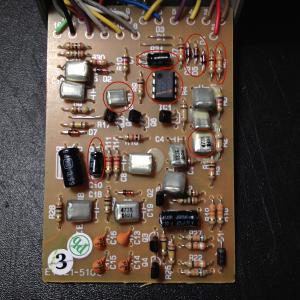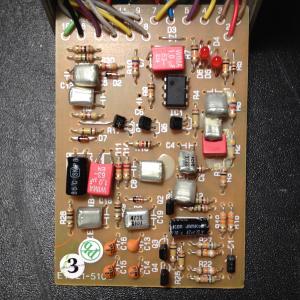Boss SD-1 modifications
Please note: New Boss SD-1 (2019 onwards) is using SMD technology, and thus needs a specific set of skills and tools to modify.

Introduction
Love it or loathe it, it’s one of the most famous pedals in the world. It’s entirely possible that every guitarist in the world has once owned, borrowed or at least tried one in music store. And like all mass-produced pedals, there is a boatload of modifications available online for this pedal. Some are free, some costs more than the pedal itself. But if you want to learn about overdrive pedals, there is no better place to start than Boss SD-1.
You can modify it very easily, and even make it as Ibanez TS9 or Ibanez TS808. Hell, I have even made a Lovepedal Eternity from SD-1! Let me show you a few basic modifications to serve as a starting point where you can begin to tinker with your own mods to this classic overdrive. These modifications are meant to give you some options to alter the tone to suit your rig.
The infamous C6
This is (or has been) the topic of some heated debate on the internet. Removing this capacitor will brighten the pedal and make it slightly more open sounding. In other words it will add a bit more clarity by removing the low pass filter. This will also make the “mid hump” a little less pronounced. It’s a simple mod, just remove capacitor C6. This can be done in minutes, and if you don’t like it, just put it back. This is a mod certainly worth trying.

More bass, not mud
This is also a very simple mod, and often done to a tube screamer. Capacitor C3 is a part of a high pass filter. Corner frequency of this filter is about 720Hz, so all frequencies below that are attenuated 6dB per octave. If we increase the value of this capacitor (stock value is 47nF) we will move the corner frequency down, and therefor cut less bass frequencies. Common value to try is 100nF, this will drop the corner frequency to about 340Hz.
More gain
In series with C3 is R6. These two components form the high pass filter we were talking about above. These two components have another function as well. These limit the amount of gain, as well as the frequencies to be clipped. If we want to get more gain from SD-1, we can change R6 to a smaller value. 2.2kΩ is common place to start, but this will also affect the corner frequency of the filter (if R6 is 2.2kΩ and C3 is stock value of 47nF the corner frequency is about 154Hz and this is too low for most of us). So if you want to add more gain and little less more bass, you have to keep the original value of C3, and change R6 to 1kΩ. If you only want more gain, and keep the original 720Hz high pass corner frequency, C3 must be 22nF and R6 1kΩ.
I know I know… this is getting a bit confusing. But filters are very important part of any pedal design and well worth experimenting with. PS. Change R5 to 10kΩ to make this pedal clean up a lot better when the drive potentiometer is turned all the way down (CCW). You’ll get clean(er) boost this way.
Clipping diodes
 Last thing we do is the most fun, until you lose your mental health after trying out all the different combinations. D4, D5 and D6 are the clipping diodes of SD-1. These form an asymmetrical clipping configuration. Remove D5 and put a jumper wire in its place, and you will have symmetrical clipping just like in tube screamers. One of my personal favorites is to use two red 3mm red LEDs in symmetrical clipping (jumper on D5, LEDs on D4 and D6). I can only say: experiment and go a bit crazy. It’s worth it!
Last thing we do is the most fun, until you lose your mental health after trying out all the different combinations. D4, D5 and D6 are the clipping diodes of SD-1. These form an asymmetrical clipping configuration. Remove D5 and put a jumper wire in its place, and you will have symmetrical clipping just like in tube screamers. One of my personal favorites is to use two red 3mm red LEDs in symmetrical clipping (jumper on D5, LEDs on D4 and D6). I can only say: experiment and go a bit crazy. It’s worth it!
You can also use a DPDT switch to select between two different clipping diode sets. In this case, remove D4, D5, D6 and wire a switch to D4. I don’t like to drill holes on pedals, or alter their appearance, so I would hide the switch in battery compartment. It’s a tight fit, but it will work. You might have to move C17 and C10 to make room for the switch, so try to use as small switch as you can find. Better yet, don't use any switch at all.
Fixing the bypass problem
If you encounter this well documented issue of SD-1, here is a solution. For this modification, you will need one 1N4148 diode, one 100nF capacitor, a J201 JFET and some wire. Here is the layout diagram for bypass fix.
From vintage to modern PSU
If you have a Boss SD-1 from the 80s or maybe early 90s, it will require a 12,6-volt Boss ACA-power adaptor. New Boss SD-1 requires a 9-volt Boss PSA-adaptor. To modify your vintage SD-1 to use 9-volt power supply, you have to replace D3 and R31 with wire jumpers. Boss did this as well, rather than designed a new PCB. I think this is a major reason why people think SD-1 sounds bad. They had a wrong power supply in the 80s and 90s! Again, me offering information we needed 30 years ago.
Changes to an SD-1 to make it CJOD
Do you remember about 15 years ago when that mysterious swirly painted Clay Jones overdrive was all the hype and shit? It was eventually discovered to be nothing but a modded $1500 tube screamer. If we believe The Gear Page, and why wouldn't we, this is how you can have a $1500 worth of tone on your bedroom floor.
- R5 = 10k
- R6 = 1k
- R7 = 1k
- R8 = 220 Ohm
- R9 = 1k
- C2 = 100nF
- C3 = 220nF
- C4 = 220nF
- C5 = 220nF
- Remove C6
- Change D4 and D6 to red 5mm LEDs and jumper D5
- Change the op-amp to a Burr Brown OPA2134 (BTW very good op-amp)
Final words
SD-1 is right up there with tube screamers, and in fact, it’s very similar in design. Stock SD-1 in front of a Marshall amplifier will blow your mind! But why is it that those green pedals are the more popular ones? To be honest, I don’t know. There is one very big difference between green tube screamers and yellow super overdrive. Price. A quick look to a few major online music stores points out that green pedals can be as much as three times more expensive than the yellow ones. And indeed, while new Boss SD-1 costs less than $60 it’s hard to ignore. And when used SD-1 can be as low as $20 it’s a real bargain.
Have fun!
